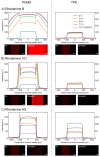Facile Patterning of Thermoplastic Elastomers and Robust Bonding to Glass and Thermoplastics for Microfluidic Cell Culture and Organ-on-Chip
- PMID: 34070209
- PMCID: PMC8158514
- DOI: 10.3390/mi12050575
Facile Patterning of Thermoplastic Elastomers and Robust Bonding to Glass and Thermoplastics for Microfluidic Cell Culture and Organ-on-Chip
Abstract
The emergence and spread of microfluidics over the last decades relied almost exclusively on the elastomer polydimethylsiloxane (PDMS). The main reason for the success of PDMS in the field of microfluidic research is its suitability for rapid prototyping and simple bonding methods. PDMS allows for precise microstructuring by replica molding and bonding to different substrates through various established strategies. However, large-scale production and commercialization efforts are hindered by the low scalability of PDMS-based chip fabrication and high material costs. Furthermore, fundamental limitations of PDMS, such as small molecule absorption and high water evaporation, have resulted in a shift toward PDMS-free systems. Thermoplastic elastomers (TPE) are a promising alternative, combining properties from both thermoplastic materials and elastomers. Here, we present a rapid and scalable fabrication method for microfluidic systems based on a polycarbonate (PC) and TPE hybrid material. Microstructured PC/TPE-hybrid modules are generated by hot embossing precise features into the TPE while simultaneously fusing the flexible TPE to a rigid thermoplastic layer through thermal fusion bonding. Compared to TPE alone, the resulting, more rigid composite material improves device handling while maintaining the key advantages of TPE. In a fast and simple process, the PC/TPE-hybrid can be bonded to several types of thermoplastics as well as glass substrates. The resulting bond strength withstands at least 7.5 bar of applied pressure, even after seven days of exposure to a high-temperature and humid environment, which makes the PC/TPE-hybrid suitable for most microfluidic applications. Furthermore, we demonstrate that the PC/TPE-hybrid features low absorption of small molecules while being biocompatible, making it a suitable material for microfluidic biotechnological applications.
Keywords: microfabrication; microfluidics; organ-on-chip; thermoplastic elastomer.
Conflict of interest statement
The authors declare no conflict of interest.
Figures




Similar articles
-
Thermoplastic elastomers for microfluidics: towards a high-throughput fabrication method of multilayered microfluidic devices.Lab Chip. 2011 Sep 21;11(18):3193-6. doi: 10.1039/c1lc20251k. Epub 2011 Jul 27. Lab Chip. 2011. PMID: 21796278
-
Reversible bonding in thermoplastic elastomer microfluidic platforms for harvestable 3D microvessel networks.Lab Chip. 2024 Oct 22;24(21):4948-4961. doi: 10.1039/d4lc00530a. Lab Chip. 2024. PMID: 39291591
-
Thermoplastic Elastomer (TPE)-Poly(Methyl Methacrylate) (PMMA) Hybrid Devices for Active Pumping PDMS-Free Organ-on-a-Chip Systems.Biosensors (Basel). 2021 May 19;11(5):162. doi: 10.3390/bios11050162. Biosensors (Basel). 2021. PMID: 34069506 Free PMC article.
-
Polymer Microfluidics: Simple, Low-Cost Fabrication Process Bridging Academic Lab Research to Commercialized Production.Micromachines (Basel). 2016 Dec 10;7(12):225. doi: 10.3390/mi7120225. Micromachines (Basel). 2016. PMID: 30404397 Free PMC article. Review.
-
Beyond Polydimethylsiloxane: Alternative Materials for Fabrication of Organ-on-a-Chip Devices and Microphysiological Systems.ACS Biomater Sci Eng. 2021 Jul 12;7(7):2880-2899. doi: 10.1021/acsbiomaterials.0c00640. Epub 2020 Sep 9. ACS Biomater Sci Eng. 2021. PMID: 34275293 Review.
Cited by
-
Rapid Prototyping of Thermoplastic Microfluidic 3D Cell Culture Devices by Creating Regional Hydrophilicity Discrepancy.Adv Sci (Weinh). 2024 Feb;11(7):e2304332. doi: 10.1002/advs.202304332. Epub 2023 Nov 30. Adv Sci (Weinh). 2024. PMID: 38032118 Free PMC article.
-
Microfluidic Systems to Mimic the Blood-Brain Barrier: from Market to Engineering Challenges and Perspectives.ACS Biomater Sci Eng. 2025 Jul 14;11(7):3789-3815. doi: 10.1021/acsbiomaterials.4c02221. Epub 2025 Jun 25. ACS Biomater Sci Eng. 2025. PMID: 40560145 Free PMC article. Review.
-
Study on the Influence of Ultrafast Laser Welding Parameters on Glass Bonding Performance.Micromachines (Basel). 2025 Jul 30;16(8):888. doi: 10.3390/mi16080888. Micromachines (Basel). 2025. PMID: 40872395 Free PMC article.
-
Standardizing designed and emergent quantitative features in microphysiological systems.Nat Biomed Eng. 2024 Aug;8(8):941-962. doi: 10.1038/s41551-024-01236-0. Epub 2024 Aug 26. Nat Biomed Eng. 2024. PMID: 39187664 Review.
-
The Fabrication and Bonding of Thermoplastic Microfluidics: A Review.Materials (Basel). 2022 Sep 18;15(18):6478. doi: 10.3390/ma15186478. Materials (Basel). 2022. PMID: 36143790 Free PMC article. Review.
References
-
- Jung W., Han J., Choi J.-W., Ahn C.H. Point-of-Care Testing (POCT) Diagnostic Systems Using Microfluidic Lab-on-a-Chip Technologies. Microelectron. Eng. 2015;132:46–57. doi: 10.1016/j.mee.2014.09.024. - DOI
-
- Fernández-la-Villa A., Pozo-Ayuso D.F., Castaño-Álvarez M. Microfluidics and Electrochemistry: An Emerging Tandem for next-Generation Analytical Microsystems. Curr. Opin. Electrochem. 2019;15:175–185. doi: 10.1016/j.coelec.2019.05.014. - DOI
-
- Zhang B., Korolj A., Lai B.F.L., Radisic M. Advances in Organ-on-a-Chip Engineering. Nat. Rev. Mater. 2018;3:257–278. doi: 10.1038/s41578-018-0034-7. - DOI
Grants and funding
LinkOut - more resources
Full Text Sources

